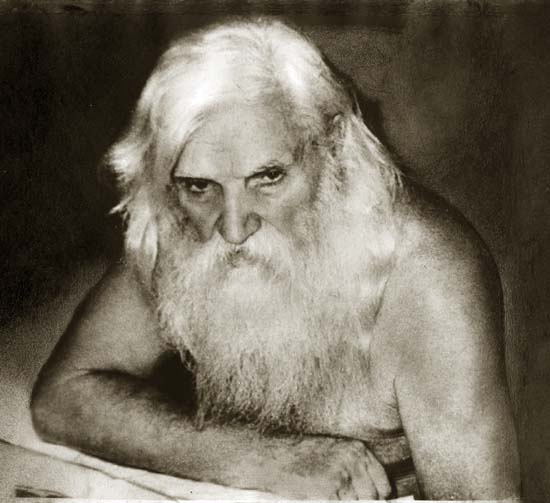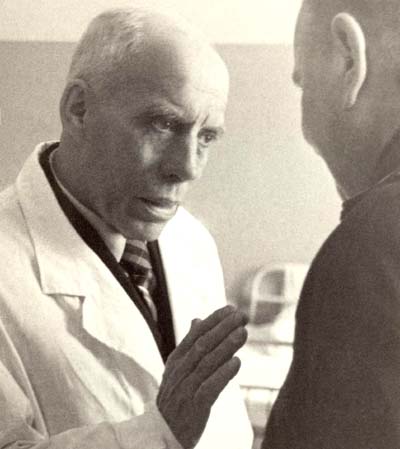Tsarist Russia - Viktor Vasilevic Pašutin
|
In Russia, Professor Viktor Vasilevic Pašutin and his collaborators made the greatest scientific contribution to the study of experimental dry fasting at the end of the 19th century. In turn, a student of the most famous doctor of that time, Professor S.P. Botkin, Viktor Pašutin, working in the Medical-Military Academy of Tsarist Russia, experimented with dry fasting on different animals for a long time and came to formulate the essence of physiological mechanisms. Pašutin for the first time quickly paid attention to the fact that in the first period of fasting there is a rapid weight loss, but subsequently, literally after a few days, this decline slows down, without prejudice to the same physiological conditions. At the time, the mechanisms that preserve energy and reduce weight loss were still unclear, but studies at the time showed that the body's protein consumption during this period is maintained at a level minimum but the cells, even those of the nervous tissue and the endocrine system do not suffer from it. If the limits of physiological fasting of animals are exceeded, a third phase occurs, during which there is a sharp decrease in body weight associated with the exhaustion of compensatory mechanisms and the degeneration of cardiac activity.
The distinction between these three characteristic phases of absolute fasting in mammals makes Vladimir Pašutin the precursor of the theory of dry fasting or endogenous food. His experiences still have not lost their importance. And precisely in subsequent experiments on different living beings, it has been shown that the first two physiological stages of fasting in different living beings have different times and precisely thanks to these periods of fasting the lifespan is prolonged compared to that of the organisms that feed regularly. For example, fasting can extend the life of worms 19 times, mice 4 times, and mammals 1.5-2 times. Already a hundred years ago, Academician V. Pašutin also noted that pathologically altered tissues are eaten during fasting. It is precisely the removal of old, diseased, dead, weak and decaying tissues and cells from the body that guarantees a powerful therapeutic effect. During this process, healthy tissues not only do not suffer but benefit from it, they renew themselves. Hence the rejuvenating effect reported by all and which makes dry fasting one of the new treatment methods of our time. A de facto method born at the dawn of mankind and used by all representatives of the animal kingdom at the beginning of the development of animal life forms existing today. A common feature of all types of fasting is the use of “tissue stores” (Viktor Pašutin) or, according to the definition of F. Benedict, the transition to an endogenous diet, which uses the energy and plastic substances released during fasting. 'a slow atrophy of a certain part of the tissues and structures of the body. The atrophic changes (simple atrophy) in the different organs and tissues propagate in a lagoonal way and their intensity is generally proportional to the duration of the fast. It has been established that during fasting there is a change in the orientation of endogenous nutrition between organs. The main proof of this principle is the fact that when animals die from starvation, there is an exceptionally different weight loss in different organs and tissues. The greatest losses occur in adipose tissue, 97% of the initial weight; liver and spleen have 53-60%, skeletal muscle 30%, blood 26%, kidney 25%, skin 20%, intestine 18%, bone 13%, nervous system 3.9% , the heart 3.6% while the brain tissue hardly loses weight. A constant of exceptional importance has thus been discovered: the expenditure of the internal reserves of the various organs and tissues is by no means uniform: the more an organ or a tissue is important for vital functions, the less weight it loses and vice versa, c that is to say, the organs and tissues of vital importance continue their existence indefinitely at the expense of the secondary tissues and organs. The profound restructuring of metabolic processes during fasting is aimed at the optimal use of reserve substances, the maximum limitation of the needs of organs and tissues that are less important for the preservation of life and during the redistribution of substances from less important organs for the most vital, a decrease in body weight loss was observed; fed after repeated fasting, the animals achieved a higher body weight, their tissues became more compact than before. The works of Russian and foreign physiologists have confirmed the following: the amount of reserves that the body can use during fasting before the onset of a state of total decay is 40-45% of its weight. It also appeared that dry fasting with a loss of body weight of up to 20-25%, i.e. an individual of 80 kg at the start, can easily go down to 60 kg without any pathological risk for his health. This fact justified the division of fasting into two types: dosed fasting and pathological fasting. In dosed fasting, the physiological stage of the food deprivation process is used when no pathological mutation (reversible phase) is yet occurring and therefore it cannot be compared to prolonged compulsory fasting which leads to dystrophy and death (irreversible pathological stage). It follows that dosed fasting are two different processes in principle. |
Soviet times - Porfirij Ivanov
|
In Soviet times, Academician Pašutin's interest in the mechanics of fasting was put into practice by a son of the people, the legendary Porfirij Ivanov, the founder of a unique healing system that also included the dry fast. Born at the end of the 19th century in Ukraine into a family of miners, after only four parish courts he went to work. Until the age of 36, he lived an ordinary life, but always thought about how to help people live a better life, not get sick and not die so early. In 1934, he had a dream that had become recurrent and made him understand that man should not fight against the negative factors of nature, but learn to exploit them in his own interest. He began to experiment with himself various procedures for tempering the body: he went out without a helmet, walked barefoot all year round, walked without a coat in winter, poured cold water on himself. He developed phenomenal powers of resistance: he could neither eat nor drink for two weeks, stay 2-3 hours under water in the sea in winter.
To challenge himself, he went for hours in the steppe in the middle of a snowstorm, covered only with his underwear, he ran hundreds of kilometers on dirt roads, in winter, undressed, he traveled for hours on locomotives. It is known that during the Nazi occupation he was buried half naked in the snow and transported on a motorbike but did not even have a cold. In addition to developing iron health, mature with remarkable bioenergetic and extrasensory abilities, which helped him recover from complex illnesses, including a case of chronic leg paralysis, psoriasis, ulcers, tuberculosis, stomach cancer and more. He lived in a period that did not allow the manifestation of these extraordinary abilities. These were the years of the revolution, the terror of the political police, the Great Patriotic War (World War II), the last years of the totalitarian regime of the Communist Party. He was arrested several times, spent 12 years in prison in psychiatric hospitals, but nothing managed to bend him. He tried to divulge his ideas through the press, but it was almost impossible in those years of rigorous administrative management. He had hundreds of followers to whom he transmitted his doctrine (Detka). |
Doctor Jurij Nikolaev, psychiatrist
60s-90s - Jurij Nikolaev
|
An important role in the spread of therapeutic wet and dry fasting was played by the famous psychiatrist Jurij Nikolaev, who already in 1960 devoted his doctoral thesis to the physiological basis of the application of fasting in the treatment of schizophrenia. Passionate about Eastern culture and fascinated by yogi lifestyle regimens, author of numerous scientific articles on the beneficial effects of decongestant therapy, Nikolaev began to successfully introduce therapeutic fasting into psychiatric practice while working in the Ministry of Institute of Health of the USSR and continued to spread it at the chair of psychiatry of the medical institute of Rostov and then Moscow, creating around him a real school of highly qualified psychiatrists and therapists who managed to open specialized fasting departments in many city and regional hospitals.
In 1990, his book Golodanie radi zdorov'ja (Fasting for his health) was released in Rostov, written with other co-authors. Nikolaev occupies a special place in the history of Russian medicine, being able to change the approach to fasting, demonstrating the therapeutic properties of fasting also dosed in psychiatric diseases. His contribution has been recognized by scholars in Japan and Germany. In India, where Nikolaev was often invited, he was made an honorary member of the Yoga Institute. In the United States, however, he was made a regular member of the Academy of Orthomolecular (Rehabilitation) Psychiatry. |
Pr, Chenikov, 1929-2019 offers the greatest contribution to the development of the therapeutic dry fasting method
|
The therapeutic dry fasting method was made by L.A. Shenikov for Therapeutic Abstention from Liquids and Foods. Photo L.A. Shennikov's Therapeutic Abstinence Method (Patent No. 2028160 under the name "Organism Rehabilitation Method") is well known in many cities of Russia and abroad for its validation in 1992. L.A. Ščennikov is a biologist and expert in alternative medicine, naturopath and healer. For more than 30 years, he has demonstrated the benefits of therapeutic abstinence at the cellular level of the body, confirmed by the results of experiments carried out by medical research institutes and by the discoveries of followers of this technique or simple people who have embarked on a path of self-healing and self-discovery and gained health and a new quality of life perception. The latter carried out a 21-day dry fast without water or food at his home in the Caucasus.
|



